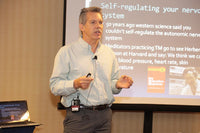
Finding Purpose and Belonging at Work: Part 1
Finding Purpose and Belonging at Work: Part 1
By James Porter
At this year’s Art and Science of Health Promotion conference in Scottsdale, Arizona, Dr. Victor Strecher, professor at the University of Michigan, delivered a compelling keynote on the power of purpose and belonging in health and workplace engagement. While some of the ideas he presented were surprising—even counterintuitive—his message was grounded in science and delivered with a sense of urgency. In this blog series, I’ll distill some of the key insights from Dr. Strecher’s talk, starting with the role of purpose and social connection in the workplace.
“We” vs. “They”: A Simple Test for Belonging
One of the simplest ways to gauge an employee’s connection to their workplace is to listen to the language they use. According to Strecher, if someone refers to their organization as “we” rather than “they,” it’s a good sign they feel a sense of belonging. That sense of identification with one’s employer isn’t just a matter of semantics—it directly correlates with employee engagement.
In fact, Strecher highlighted research showing a dramatic difference in engagement between those who feel they belong (roughly 75% engagement) and those who don’t (about 30%). While the exact source of the statistic wasn’t specified, the message was clear: belonging more than doubles the likelihood of an employee being engaged. That’s a powerful takeaway for anyone managing a team or trying to improve workplace culture.
Isolation, Anxiety, and the Brain
Strecher also explored the growing epidemic of isolation in American life. “Do you dine alone?” he asked, noting that more Americans than ever are eating meals solo. This loneliness isn’t just a social problem—it has measurable impacts on mental health and job performance. As isolation increases, so does anxiety. And with anxiety comes a cascade of workplace problems: lower engagement, burnout, job dissatisfaction, and depression.
Interestingly, Strecher’s research found that people tend to feel less resilient and more anxious on Tuesdays, a phenomenon that remains unexplained but points to deeper patterns in mood and engagement throughout the week.
To explain these effects, Strecher turned to the brain. He showed slides of MRI research tracking blood flow to the amygdala—the brain’s threat detection center. In one striking example, a participant watched videos of threatening stimuli, such as a rabid dog lunging toward the camera, while in an MRI machine. Researchers could literally see the participant’s amygdala light up in response. This was a vivid demonstration of how our brain processes threat, fear, and anxiety—and how that impacts our ability to engage in work and life.
From Fear to Purpose: The Role of Values
So what can we do about all this? Strecher argued that while we can’t eliminate anxiety, we can help people manage it by anchoring them in a sense of purpose. In one study, participants who were sedentary and looking to improve their behavior were split into two groups. One group was asked to focus on building skills. The other was first asked to reflect on their core values and then received the same skill-building materials. The result? Those who connected with their values were significantly more likely to reduce their sedentary behavior.
This study suggests that tapping into what people care about most—their families, communities, passions—activates the prefrontal cortex (PFC), the part of the brain involved in self-regulation and long-term planning. Strecher emphasized that we need to stop studying the PFC and the amygdala in isolation, and instead focus on the interaction between the two. A sense of purpose, which originates in the PFC in a very real sense, that helps the brain override fear, which originates in the amygdala.
The Power of Loving-Kindness
Strecher also guided attendees through a brief Loving-Kindness Meditation, repeating phrases like “May you be at peace” and “May you be free from suffering.” He asked how many people were familiar with the practice. Roughly 50 raised their hands. Fewer had actually done it, and only about five reported having a regular practice. This simple meditation, he suggested, is another tool for cultivating resilience and reducing isolation.
Connecting the Dots
As Dr. Strecher’s talk made clear, the future of workplace health isn’t just about physical wellness or financial incentives. It's about helping people reconnect with their values, build social bonds, and find purpose in what they do. Organizations spend millions of dollars each year trying to nudge employees toward better health—often through extrinsic tools like Health Risk Assessments (HRAs). But what if that money was instead used to support employees in causes they care about? Strecher floated the idea of allowing people to direct HRA incentives to charities of their choice—an example of purpose-driven motivation in action.
In the next installment, we’ll dive deeper into the evolving field of Wellbeing 3.0, explore Strecher’s insights on emotional self-management, and look at why he believes purpose belongs at the base of Maslow’s hierarchy, not the top.





James Porter
Author